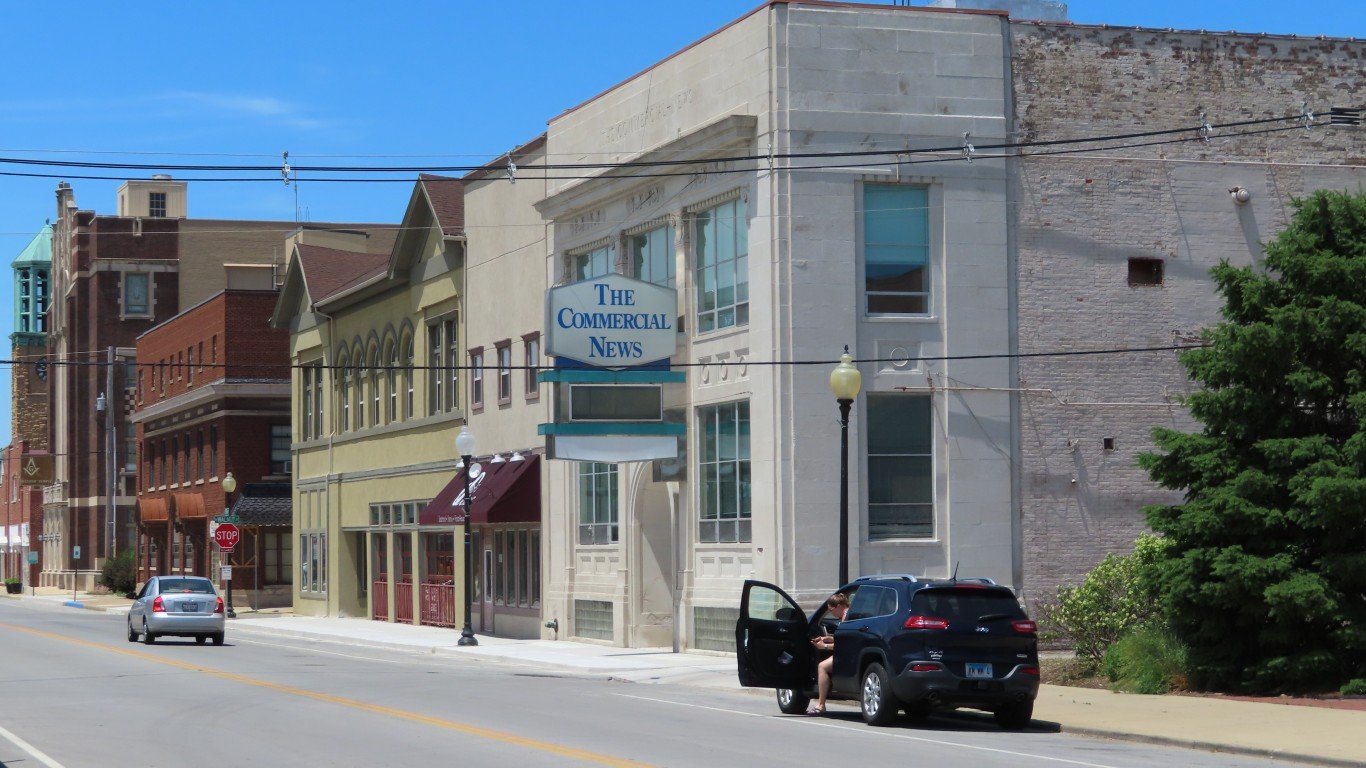

The U.S. has reported more than 43.6 million confirmed COVID-19 cases as of October 7. There have been more than 700,000 reported deaths from COVID-19-related causes — the highest death toll of any country.
The extent of the spread of the novel coronavirus continues to vary considerably from state to state, and from city to city. Even as the number of daily new cases is flattening or even declining in some parts of the country, it is surging at a growing rate in others.
Nationwide, the number of new cases is growing at a steady rate. There were an average of 33.0 daily new coronavirus cases per 100,000 Americans in the week ending October 7, essentially unchanged from the week prior, when there were an average of 37.5 daily new coronavirus cases per 100,000 people.
Metropolitan areas with a high degree of mobility and a large population may be particularly vulnerable to outbreaks. While science and medical professionals are still studying how exactly the virus spreads, experts agree that outbreaks are more likely to occur in group settings where large numbers of people routinely have close contact with one another. Cities with high concentrations of dense spaces such as colleges, correctional facilities, and nursing homes are particularly at risk.
The city with the highest seven-day average of new daily COVID-19 cases per capita is in Alaska. In the Fairbanks, AK, metro area, there were an average of 185.0 daily new coronavirus cases per 100,000 residents in the week ending October 7, the most of any U.S. metro area. Other cities where COVID-19 is growing the fastest include Anchorage, AK; Bismarck, ND; and Abilene, TX.
To determine the metropolitan area in each state where COVID-19 is growing the fastest, 24/7 Wall St. compiled and reviewed data from state and local health departments. We ranked metropolitan areas according to the average number of new daily COVID-19 cases per 100,000 residents in the seven days ending October 7. Data was aggregated from the county level to the metropolitan area level using boundary definitions from the U.S. Census Bureau. Population data used to adjust case and death totals came from the U.S. Census Bureau’s 2019 American Community Survey and are five-year estimates. Unemployment data is from the Bureau of Labor Statistics and is seasonally adjusted.
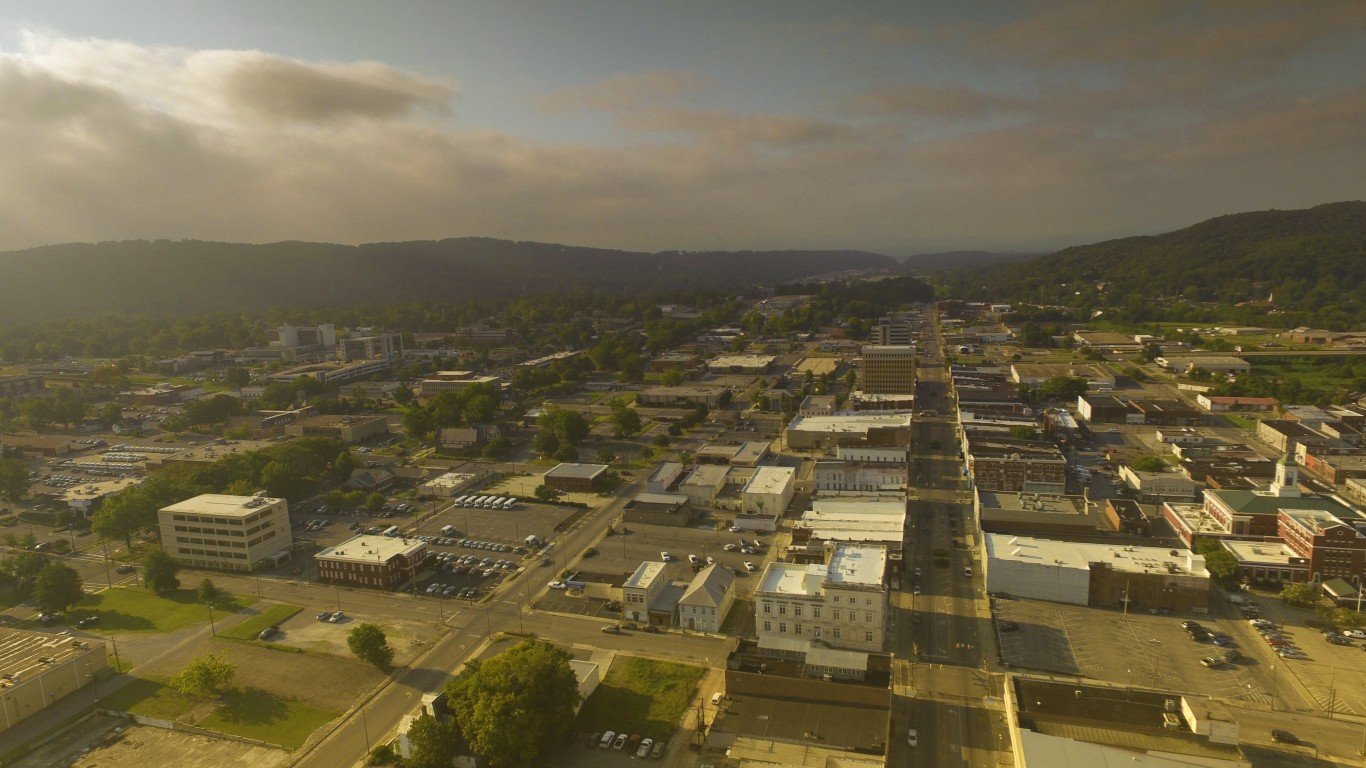
Alabama: Anniston-Oxford
Avg. new daily cases in Anniston in week ending October 7: 73.7 per 100,000
Avg. new daily cases in Anniston in week ending September 30: 129.6 per 100,000
COVID-19 cases in Anniston as of October 7: 21,774 (18,997.0 per 100,000)
Peak pandemic unemployment in Anniston: 18.7% (April 2020)
Anniston population: 114,618 (189.2 people per sq. mi.)
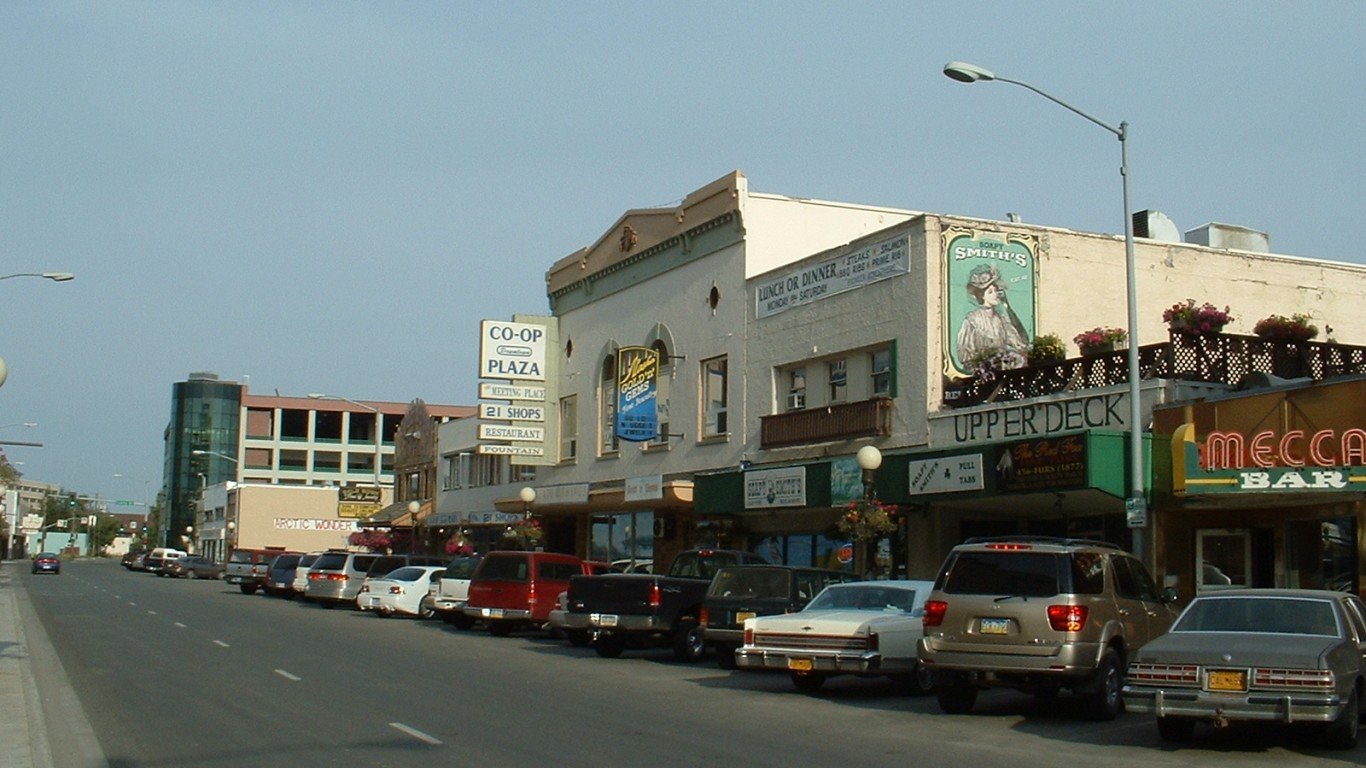
Alaska: Fairbanks
Avg. new daily cases in Fairbanks in week ending October 7: 185.0 per 100,000
Avg. new daily cases in Fairbanks in week ending September 30: 141.6 per 100,000
COVID-19 cases in Fairbanks as of October 7: 13,590 (13,717.3 per 100,000)
Peak pandemic unemployment in Fairbanks: 11.4% (April 2020)
Fairbanks population: 99,072 (13.5 people per sq. mi.)
These are all the counties in Alaska where COVID-19 is slowing (and where it’s still getting worse).

Arizona: Lake Havasu City-Kingman
Avg. new daily cases in Lake Havasu City in week ending October 7: 41.1 per 100,000
Avg. new daily cases in Lake Havasu City in week ending September 30: 44.4 per 100,000
COVID-19 cases in Lake Havasu City as of October 7: 31,675 (15,250.7 per 100,000)
Peak pandemic unemployment in Lake Havasu City: 19.8% (April 2020)
Lake Havasu City population: 207,695 (15.6 people per sq. mi.)

Arkansas: Jonesboro
Avg. new daily cases in Jonesboro in week ending October 7: 46.2 per 100,000
Avg. new daily cases in Jonesboro in week ending September 30: 67.4 per 100,000
COVID-19 cases in Jonesboro as of October 7: 25,762 (19,629.5 per 100,000)
Peak pandemic unemployment in Jonesboro: 9.3% (April 2020)
Jonesboro population: 131,241 (89.5 people per sq. mi.)

California: Hanford-Corcoran
Avg. new daily cases in Hanford in week ending October 7: 66.6 per 100,000
Avg. new daily cases in Hanford in week ending September 30: 58.6 per 100,000
COVID-19 cases in Hanford as of October 7: 31,535 (20,926.9 per 100,000)
Peak pandemic unemployment in Hanford: 16.6% (April 2020)
Hanford population: 150,691 (108.5 people per sq. mi.)

Colorado: Grand Junction
Avg. new daily cases in Grand Junction in week ending October 7: 56.4 per 100,000
Avg. new daily cases in Grand Junction in week ending September 30: 45.8 per 100,000
COVID-19 cases in Grand Junction as of October 7: 21,989 (14,541.3 per 100,000)
Peak pandemic unemployment in Grand Junction: 12.5% (April 2020)
Grand Junction population: 151,218 (45.4 people per sq. mi.)

Connecticut: Norwich-New London
Avg. new daily cases in Norwich in week ending October 7: 18.9 per 100,000
Avg. new daily cases in Norwich in week ending September 30: 19.6 per 100,000
COVID-19 cases in Norwich as of October 7: 26,603 (9,949.1 per 100,000)
Peak pandemic unemployment in Norwich: 15.0% (May 2020)
Norwich population: 267,390 (402.2 people per sq. mi.)

Delaware: Dover
Avg. new daily cases in Dover in week ending October 7: 56.2 per 100,000
Avg. new daily cases in Dover in week ending September 30: 59.8 per 100,000
COVID-19 cases in Dover as of October 7: 24,180 (13,684.3 per 100,000)
Peak pandemic unemployment in Dover: 17.3% (May 2020)
Dover population: 176,699 (301.4 people per sq. mi.)
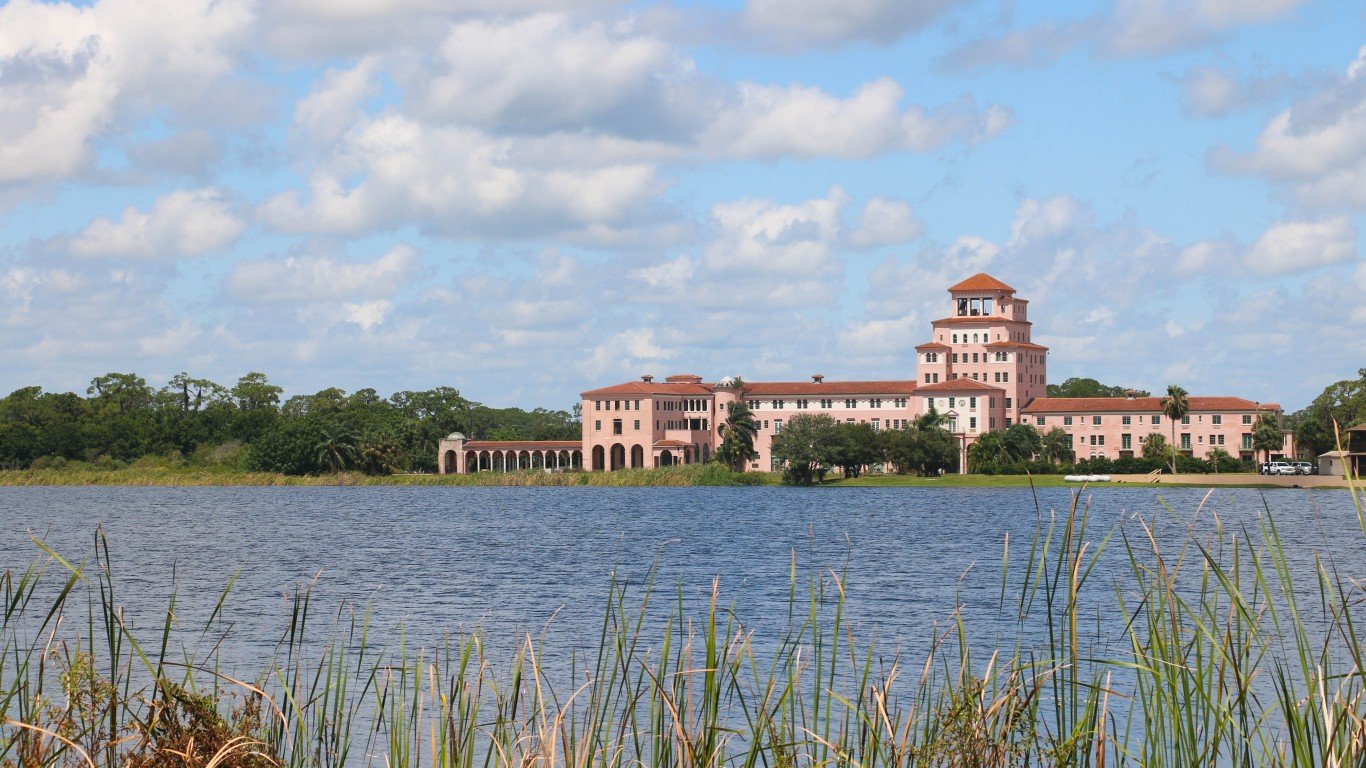
Florida: Sebring-Avon Park
Avg. new daily cases in Sebring in week ending October 7: 41.0 per 100,000
Avg. new daily cases in Sebring in week ending September 30: 79.1 per 100,000
COVID-19 cases in Sebring as of October 7: 15,652 (15,131.9 per 100,000)
Peak pandemic unemployment in Sebring: 11.3% (April 2020)
Sebring population: 103,437 (101.7 people per sq. mi.)

Georgia: Dalton
Avg. new daily cases in Dalton in week ending October 7: 50.5 per 100,000
Avg. new daily cases in Dalton in week ending September 30: 59.8 per 100,000
COVID-19 cases in Dalton as of October 7: 29,126 (20,231.9 per 100,000)
Peak pandemic unemployment in Dalton: 20.3% (April 2020)
Dalton population: 143,961 (226.7 people per sq. mi.)

Hawaii: Urban Honolulu
Avg. new daily cases in Urban Honolulu in week ending October 7: 20.0 per 100,000
Avg. new daily cases in Urban Honolulu in week ending September 30: 27.6 per 100,000
COVID-19 cases in Urban Honolulu as of October 7: 55,821 (5,668.1 per 100,000)
Peak pandemic unemployment in Urban Honolulu: 20.7% (April 2020)
Urban Honolulu population: 984,821 (1,639.3 people per sq. mi.)
These are all the counties in Hawaii where COVID-19 is slowing (and where it’s still getting worse).

Idaho: Boise City
Avg. new daily cases in Boise City in week ending October 7: 91.8 per 100,000
Avg. new daily cases in Boise City in week ending September 30: 77.4 per 100,000
COVID-19 cases in Boise City as of October 7: 115,330 (16,226.7 per 100,000)
Peak pandemic unemployment in Boise City: 12.6% (April 2020)
Boise City population: 710,743 (60.4 people per sq. mi.)
These are all the counties in Idaho where COVID-19 is slowing (and where it’s still getting worse).
Illinois: Danville
Avg. new daily cases in Danville in week ending October 7: 53.9 per 100,000
Avg. new daily cases in Danville in week ending September 30: 73.6 per 100,000
COVID-19 cases in Danville as of October 7: 13,763 (17,744.3 per 100,000)
Peak pandemic unemployment in Danville: 18.4% (April 2020)
Danville population: 77,563 (86.3 people per sq. mi.)

Indiana: Terre Haute
Avg. new daily cases in Terre Haute in week ending October 7: 55.1 per 100,000
Avg. new daily cases in Terre Haute in week ending September 30: 67.3 per 100,000
COVID-19 cases in Terre Haute as of October 7: 28,859 (15,440.2 per 100,000)
Peak pandemic unemployment in Terre Haute: 17.2% (April 2020)
Terre Haute population: 186,908 (97.9 people per sq. mi.)
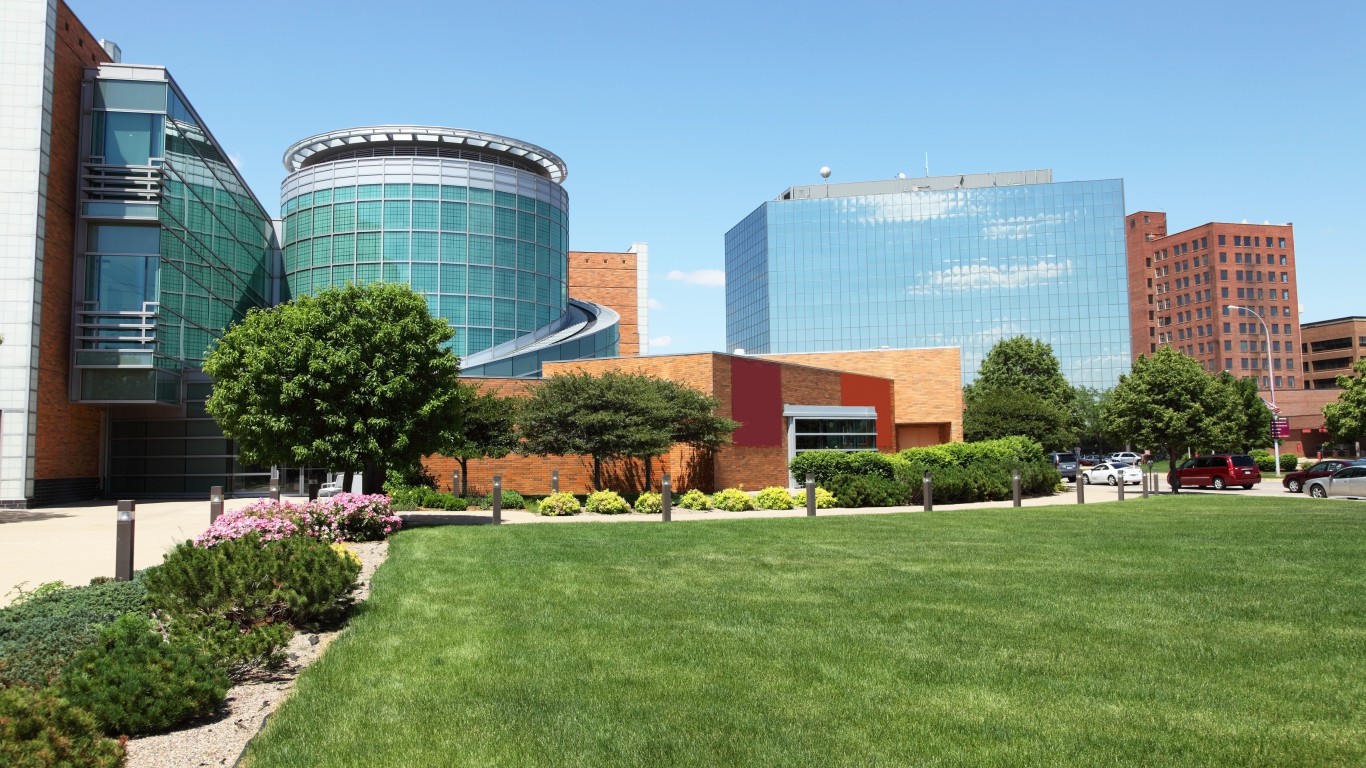
Iowa: Sioux City, IA-NE-SD
Avg. new daily cases in Sioux City in week ending October 7: 56.1 per 100,000
Avg. new daily cases in Sioux City in week ending September 30: 99.4 per 100,000
COVID-19 cases in Sioux City as of October 7: 25,670 (17,845.5 per 100,000)
Peak pandemic unemployment in Sioux City: 9.8% (April 2020)
Sioux City population: 143,846 (69.4 people per sq. mi.)
These are all the counties in Iowa where COVID-19 is slowing (and where it’s still getting worse).

Kansas: Wichita
Avg. new daily cases in Wichita in week ending October 7: 45.9 per 100,000
Avg. new daily cases in Wichita in week ending September 30: 54.4 per 100,000
COVID-19 cases in Wichita as of October 7: 95,370 (14,955.5 per 100,000)
Peak pandemic unemployment in Wichita: 18.2% (April 2020)
Wichita population: 637,690 (153.7 people per sq. mi.)
These are all the counties in Kansas where COVID-19 is slowing (and where it’s still getting worse).
Kentucky: Louisville/Jefferson County, KY-IN
Avg. new daily cases in Louisville/Jefferson County in week ending October 7: 64.3 per 100,000
Avg. new daily cases in Louisville/Jefferson County in week ending September 30: 54.4 per 100,000
COVID-19 cases in Louisville/Jefferson County as of October 7: 185,832 (14,782.7 per 100,000)
Peak pandemic unemployment in Louisville/Jefferson County: 17.4% (April 2020)
Louisville/Jefferson County population: 1,257,088 (388.4 people per sq. mi.)

Louisiana: Monroe
Avg. new daily cases in Monroe in week ending October 7: 46.4 per 100,000
Avg. new daily cases in Monroe in week ending September 30: 52.8 per 100,000
COVID-19 cases in Monroe as of October 7: 39,022 (19,179.5 per 100,000)
Peak pandemic unemployment in Monroe: 12.8% (April 2020)
Monroe population: 203,457 (89.1 people per sq. mi.)

Maine: Bangor
Avg. new daily cases in Bangor in week ending October 7: 62.7 per 100,000
Avg. new daily cases in Bangor in week ending September 30: 73.4 per 100,000
COVID-19 cases in Bangor as of October 7: 10,850 (7,148.8 per 100,000)
Peak pandemic unemployment in Bangor: 9.6% (April 2020)
Bangor population: 151,774 (44.7 people per sq. mi.)
These are all the counties in Maine where COVID-19 is slowing (and where it’s still getting worse).

Maryland: Cumberland, MD-WV
Avg. new daily cases in Cumberland in week ending October 7: 67.1 per 100,000
Avg. new daily cases in Cumberland in week ending September 30: 77.7 per 100,000
COVID-19 cases in Cumberland as of October 7: 13,374 (13,562.2 per 100,000)
Peak pandemic unemployment in Cumberland: 14.0% (April 2020)
Cumberland population: 98,612 (131.1 people per sq. mi.)

Massachusetts: Worcester, MA-CT
Avg. new daily cases in Worcester in week ending October 7: 28.3 per 100,000
Avg. new daily cases in Worcester in week ending September 30: 30.9 per 100,000
COVID-19 cases in Worcester as of October 7: 103,688 (11,015.0 per 100,000)
Peak pandemic unemployment in Worcester: 15.9% (June 2020)
Worcester population: 941,338 (465.2 people per sq. mi.)

Michigan: Bay City
Avg. new daily cases in Bay City in week ending October 7: 61.8 per 100,000
Avg. new daily cases in Bay City in week ending September 30: 46.9 per 100,000
COVID-19 cases in Bay City as of October 7: 13,327 (12,801.6 per 100,000)
Peak pandemic unemployment in Bay City: 25.6% (April 2020)
Bay City population: 104,104 (235.4 people per sq. mi.)
Minnesota: St. Cloud
Avg. new daily cases in St. Cloud in week ending October 7: 72.0 per 100,000
Avg. new daily cases in St. Cloud in week ending September 30: 55.9 per 100,000
COVID-19 cases in St. Cloud as of October 7: 33,703 (16,971.9 per 100,000)
Peak pandemic unemployment in St. Cloud: 9.4% (May 2020)
St. Cloud population: 198,581 (113.4 people per sq. mi.)
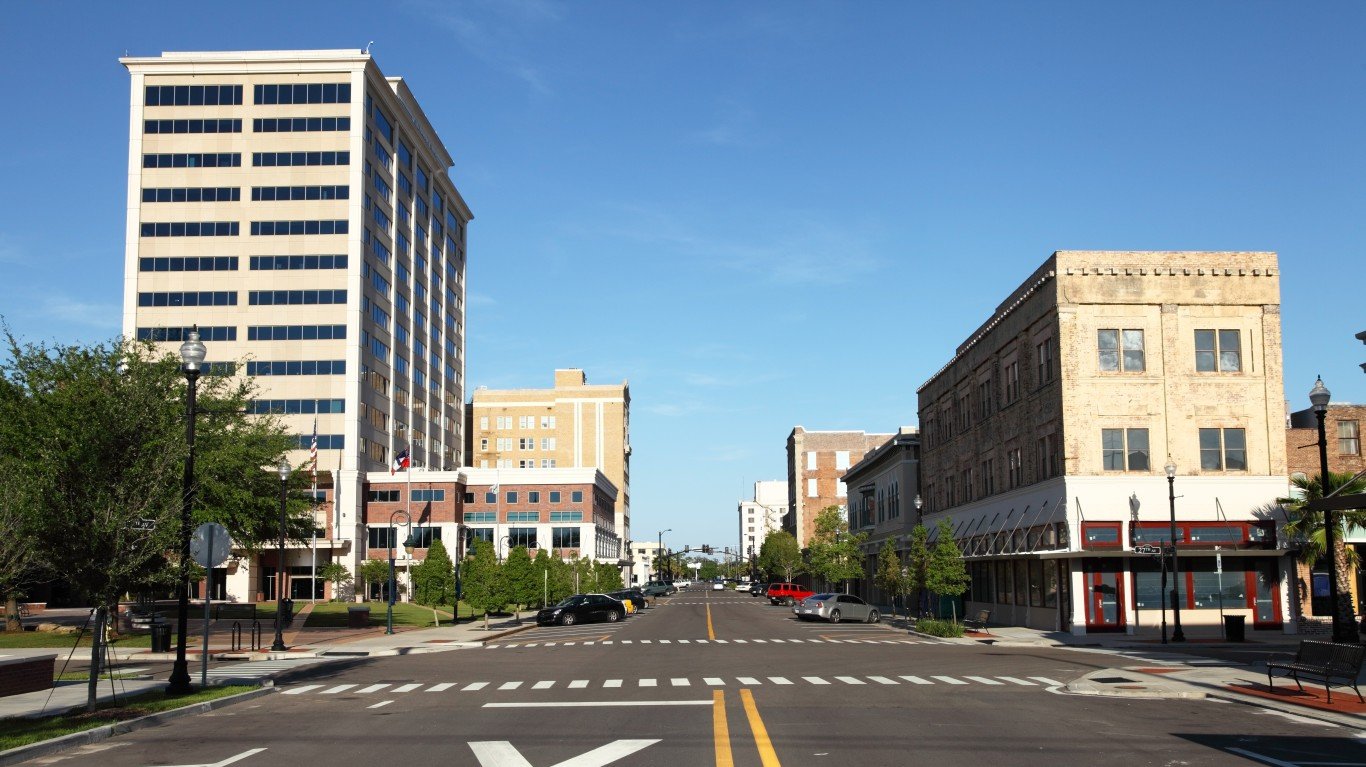
Mississippi: Gulfport-Biloxi
Avg. new daily cases in Gulfport in week ending October 7: 34.0 per 100,000
Avg. new daily cases in Gulfport in week ending September 30: 55.4 per 100,000
COVID-19 cases in Gulfport as of October 7: 68,932 (16,726.4 per 100,000)
Peak pandemic unemployment in Gulfport: 22.3% (April 2020)
Gulfport population: 412,115 (186.0 people per sq. mi.)

Missouri: Cape Girardeau, MO-IL
Avg. new daily cases in Cape Girardeau in week ending October 7: 33.1 per 100,000
Avg. new daily cases in Cape Girardeau in week ending September 30: 49.5 per 100,000
COVID-19 cases in Cape Girardeau as of October 7: 14,324 (14,770.7 per 100,000)
Peak pandemic unemployment in Cape Girardeau: 10.1% (April 2020)
Cape Girardeau population: 96,976 (67.7 people per sq. mi.)

Montana: Great Falls
Avg. new daily cases in Great Falls in week ending October 7: 86.7 per 100,000
Avg. new daily cases in Great Falls in week ending September 30: 94.0 per 100,000
COVID-19 cases in Great Falls as of October 7: 13,479 (16,513.3 per 100,000)
Peak pandemic unemployment in Great Falls: 12.6% (April 2020)
Great Falls population: 81,625 (30.3 people per sq. mi.)

Nebraska: Grand Island
Avg. new daily cases in Grand Island in week ending October 7: 33.9 per 100,000
Avg. new daily cases in Grand Island in week ending September 30: 228.2 per 100,000
COVID-19 cases in Grand Island as of October 7: 11,126 (14,740.3 per 100,000)
Peak pandemic unemployment in Grand Island: 11.4% (April 2020)
Grand Island population: 75,480 (47.2 people per sq. mi.)

Nevada: Reno
Avg. new daily cases in Reno in week ending October 7: 38.8 per 100,000
Avg. new daily cases in Reno in week ending September 30: 51.3 per 100,000
COVID-19 cases in Reno as of October 7: 62,407 (13,539.5 per 100,000)
Peak pandemic unemployment in Reno: 20.5% (April 2020)
Reno population: 460,924 (70.2 people per sq. mi.)
These are all the counties in Nevada where COVID-19 is slowing (and where it’s still getting worse).
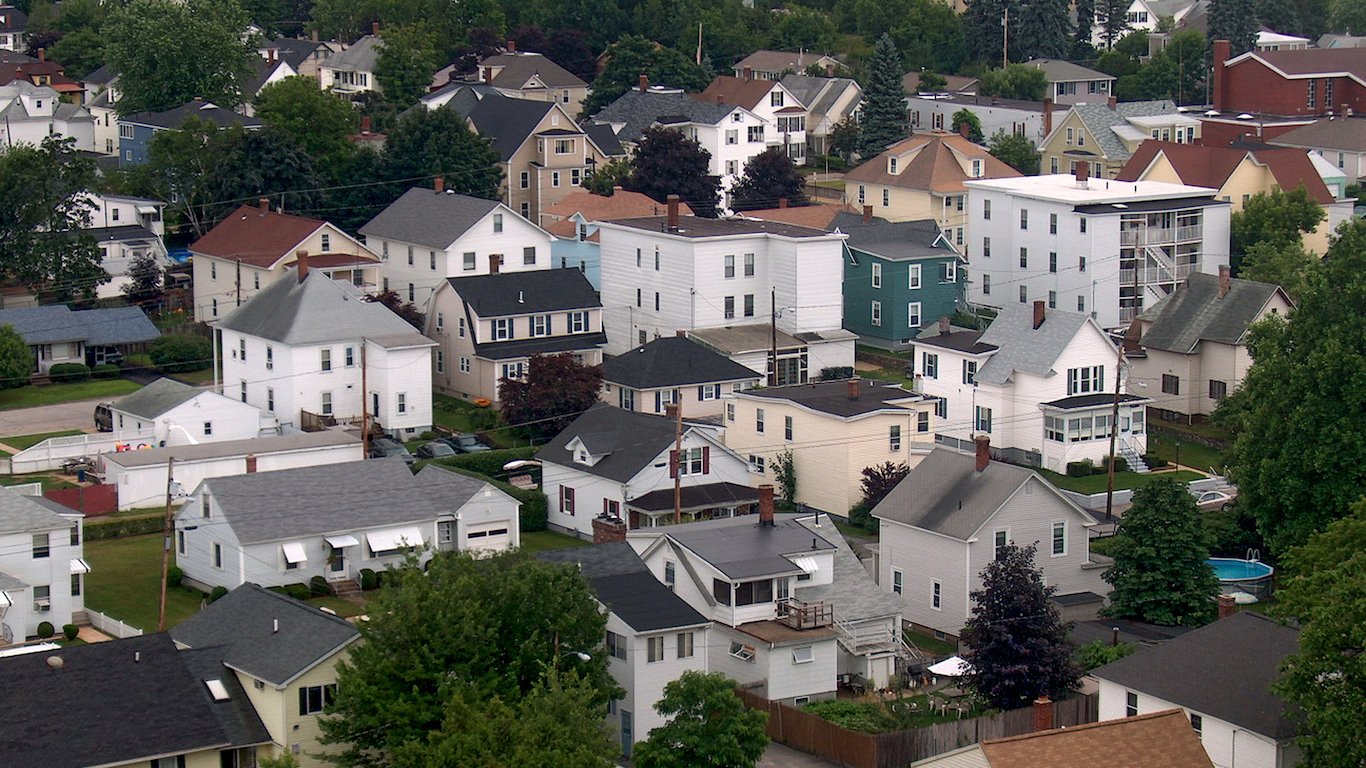
New Hampshire: Manchester-Nashua
Avg. new daily cases in Manchester in week ending October 7: 36.0 per 100,000
Avg. new daily cases in Manchester in week ending September 30: 27.5 per 100,000
COVID-19 cases in Manchester as of October 7: 42,852 (10,374.9 per 100,000)
Peak pandemic unemployment in Manchester: 17.5% (April 2020)
Manchester population: 413,035 (471.4 people per sq. mi.)

New Jersey: Ocean City
Avg. new daily cases in Ocean City in week ending October 7: 36.8 per 100,000
Avg. new daily cases in Ocean City in week ending September 30: 37.4 per 100,000
COVID-19 cases in Ocean City as of October 7: 12,014 (12,906.3 per 100,000)
Peak pandemic unemployment in Ocean City: 26.6% (June 2020)
Ocean City population: 93,086 (370.2 people per sq. mi.)

New Mexico: Farmington
Avg. new daily cases in Farmington in week ending October 7: 54.1 per 100,000
Avg. new daily cases in Farmington in week ending September 30: 33.4 per 100,000
COVID-19 cases in Farmington as of October 7: 18,875 (14,919.2 per 100,000)
Peak pandemic unemployment in Farmington: 14.5% (July 2020)
Farmington population: 126,515 (22.9 people per sq. mi.)
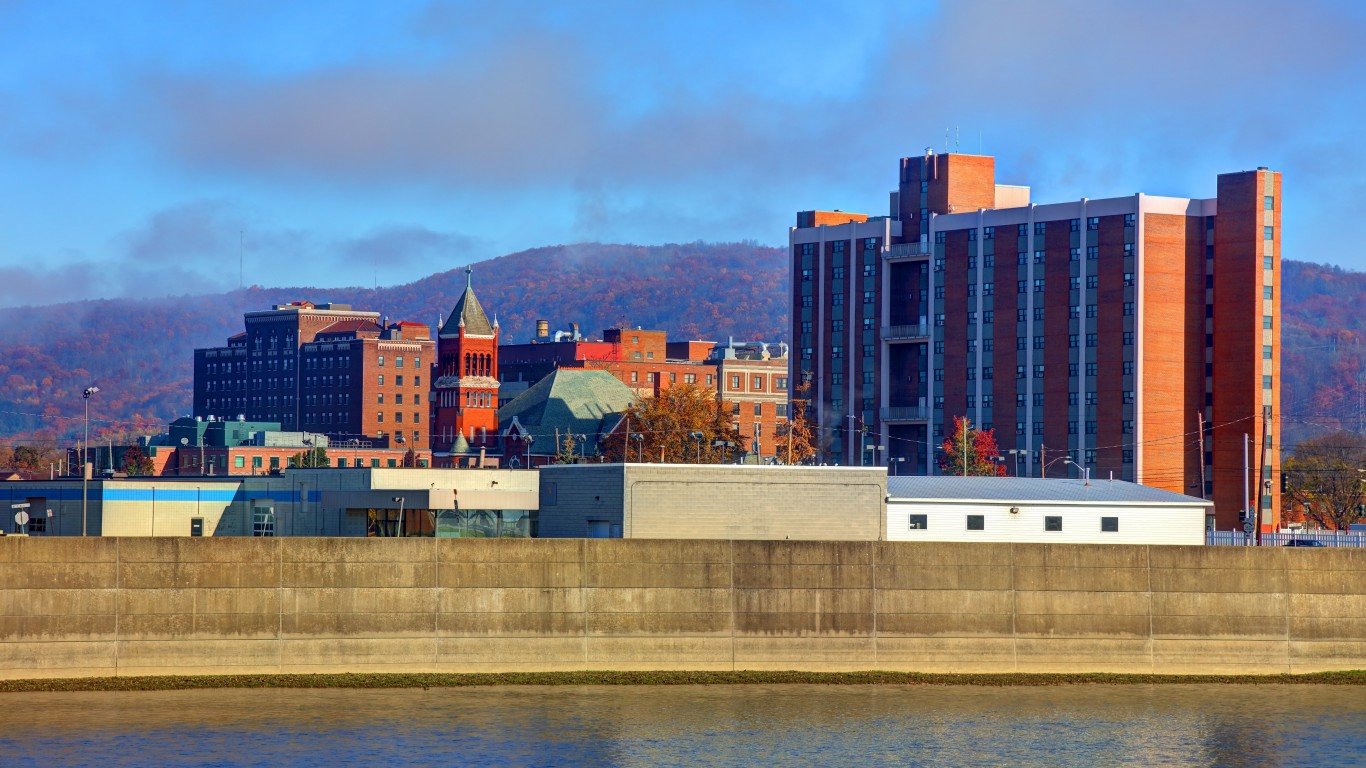
New York: Elmira
Avg. new daily cases in Elmira in week ending October 7: 75.3 per 100,000
Avg. new daily cases in Elmira in week ending September 30: 64.1 per 100,000
COVID-19 cases in Elmira as of October 7: 9,855 (11,608.5 per 100,000)
Peak pandemic unemployment in Elmira: 16.4% (April 2020)
Elmira population: 84,895 (208.4 people per sq. mi.)

North Carolina: Jacksonville
Avg. new daily cases in Jacksonville in week ending October 7: 65.3 per 100,000
Avg. new daily cases in Jacksonville in week ending September 30: 67.1 per 100,000
COVID-19 cases in Jacksonville as of October 7: 26,921 (13,800.8 per 100,000)
Peak pandemic unemployment in Jacksonville: 12.6% (April 2020)
Jacksonville population: 195,069 (255.7 people per sq. mi.)
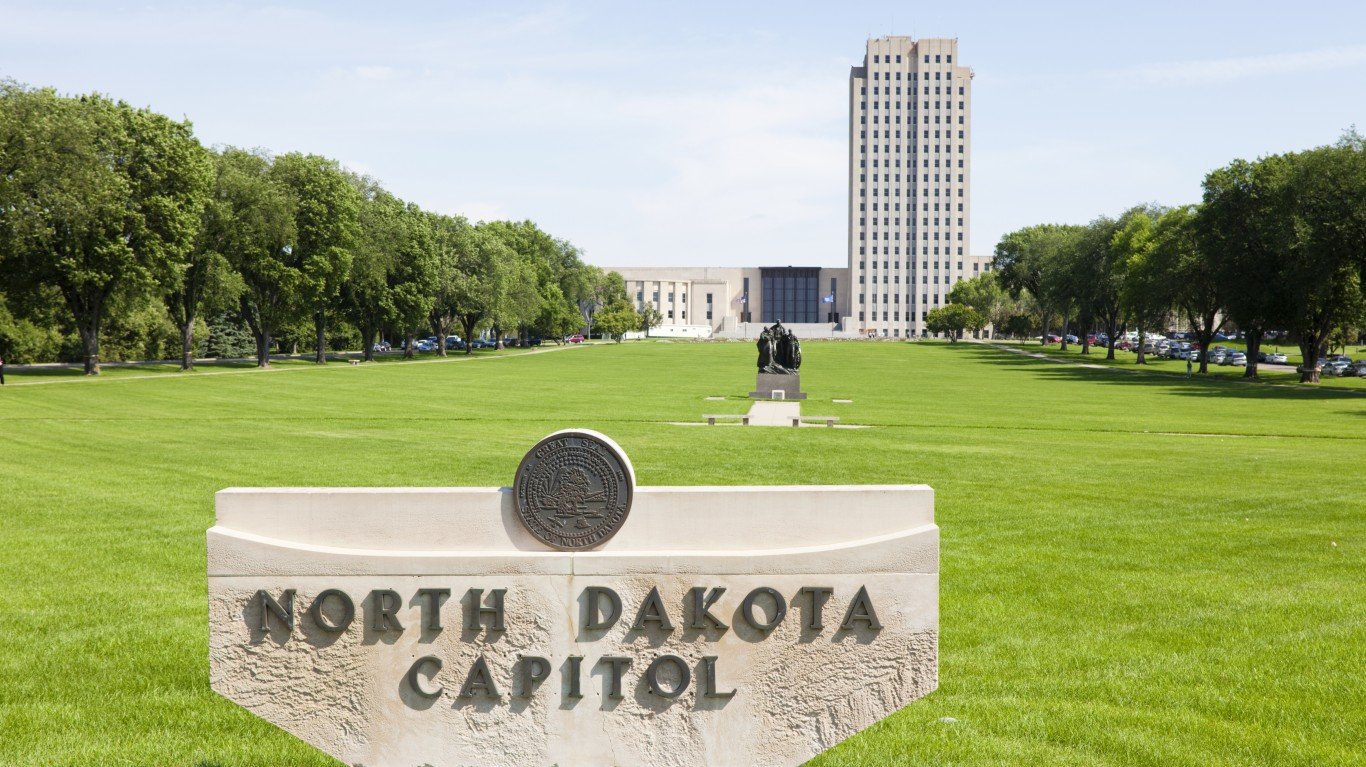
North Dakota: Bismarck
Avg. new daily cases in Bismarck in week ending October 7: 132.4 per 100,000
Avg. new daily cases in Bismarck in week ending September 30: 108.3 per 100,000
COVID-19 cases in Bismarck as of October 7: 27,532 (21,593.2 per 100,000)
Peak pandemic unemployment in Bismarck: 9.5% (April 2020)
Bismarck population: 127,503 (29.8 people per sq. mi.)

Ohio: Mansfield
Avg. new daily cases in Mansfield in week ending October 7: 77.5 per 100,000
Avg. new daily cases in Mansfield in week ending September 30: 86.4 per 100,000
COVID-19 cases in Mansfield as of October 7: 17,489 (14,441.8 per 100,000)
Peak pandemic unemployment in Mansfield: 20.4% (April 2020)
Mansfield population: 121,100 (244.5 people per sq. mi.)
These are all the counties in Ohio where COVID-19 is slowing (and where it’s still getting worse).

Oklahoma: Lawton
Avg. new daily cases in Lawton in week ending October 7: 79.5 per 100,000
Avg. new daily cases in Lawton in week ending September 30: 74.3 per 100,000
COVID-19 cases in Lawton as of October 7: 21,050 (16,494.3 per 100,000)
Peak pandemic unemployment in Lawton: 19.5% (April 2020)
Lawton population: 127,620 (75.0 people per sq. mi.)

Oregon: Bend
Avg. new daily cases in Bend in week ending October 7: 72.1 per 100,000
Avg. new daily cases in Bend in week ending September 30: 62.5 per 100,000
COVID-19 cases in Bend as of October 7: 18,547 (9,958.1 per 100,000)
Peak pandemic unemployment in Bend: 18.3% (April 2020)
Bend population: 186,251 (61.7 people per sq. mi.)
These are all the counties in Oregon where COVID-19 is slowing (and where it’s still getting worse).

Pennsylvania: Chambersburg-Waynesboro
Avg. new daily cases in Chambersburg in week ending October 7: 65.7 per 100,000
Avg. new daily cases in Chambersburg in week ending September 30: 66.4 per 100,000
COVID-19 cases in Chambersburg as of October 7: 20,214 (13,113.5 per 100,000)
Peak pandemic unemployment in Chambersburg: 13.3% (April 2020)
Chambersburg population: 154,147 (199.6 people per sq. mi.)

Rhode Island: Providence-Warwick, RI-MA
Avg. new daily cases in Providence in week ending October 7: 27.9 per 100,000
Avg. new daily cases in Providence in week ending September 30: 46.1 per 100,000
COVID-19 cases in Providence as of October 7: 237,526 (14,677.8 per 100,000)
Peak pandemic unemployment in Providence: 18.5% (April 2020)
Providence population: 1,618,268 (1,019.8 people per sq. mi.)

South Carolina: Spartanburg
Avg. new daily cases in Spartanburg in week ending October 7: 84.1 per 100,000
Avg. new daily cases in Spartanburg in week ending September 30: 82.7 per 100,000
COVID-19 cases in Spartanburg as of October 7: 59,759 (19,426.4 per 100,000)
Peak pandemic unemployment in Spartanburg: 15.5% (April 2020)
Spartanburg population: 307,617 (380.7 people per sq. mi.)
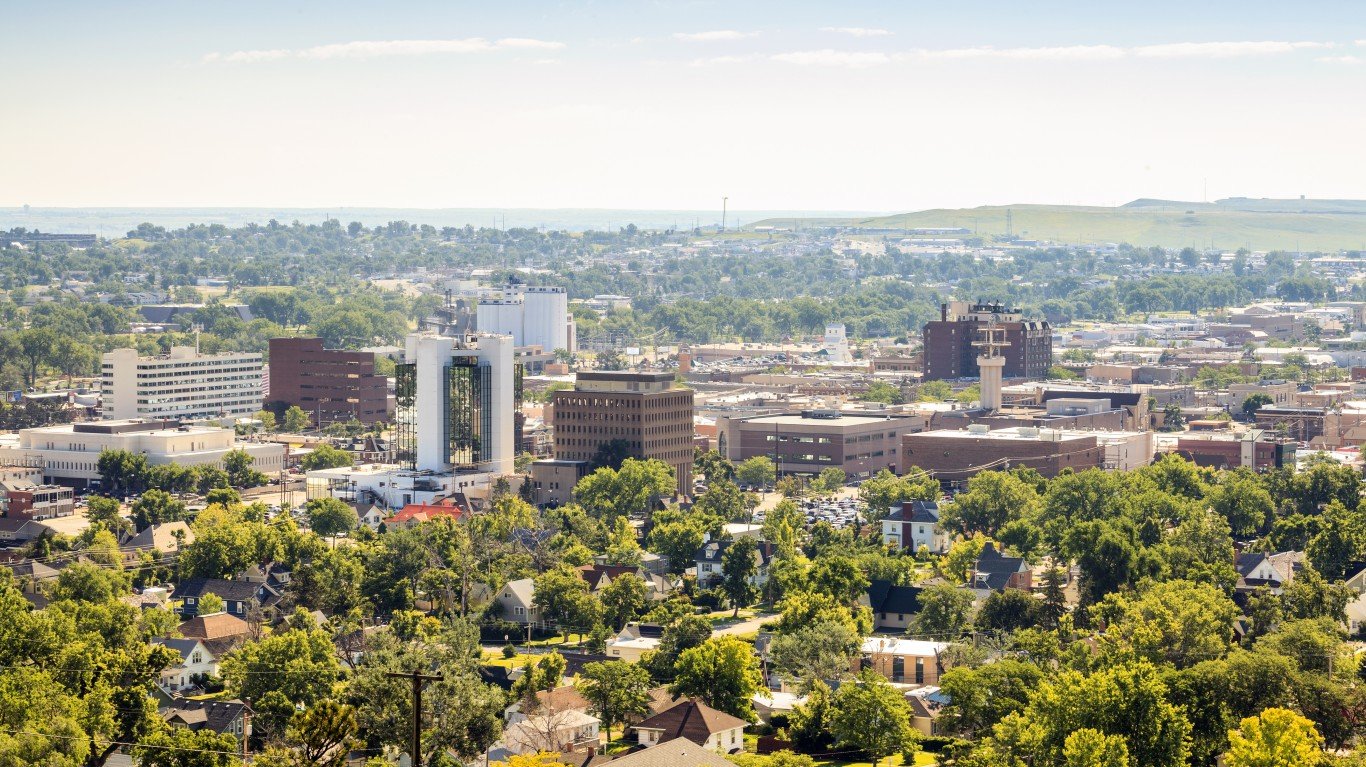
South Dakota: Rapid City
Avg. new daily cases in Rapid City in week ending October 7: 68.7 per 100,000
Avg. new daily cases in Rapid City in week ending September 30: 79.8 per 100,000
COVID-19 cases in Rapid City as of October 7: 23,491 (16,973.0 per 100,000)
Peak pandemic unemployment in Rapid City: 13.8% (April 2020)
Rapid City population: 138,402 (22.2 people per sq. mi.)

Tennessee: Knoxville
Avg. new daily cases in Knoxville in week ending October 7: 58.2 per 100,000
Avg. new daily cases in Knoxville in week ending September 30: 80.0 per 100,000
COVID-19 cases in Knoxville as of October 7: 142,711 (16,723.9 per 100,000)
Peak pandemic unemployment in Knoxville: 14.1% (April 2020)
Knoxville population: 853,337 (265.0 people per sq. mi.)

Texas: Abilene
Avg. new daily cases in Abilene in week ending October 7: 106.0 per 100,000
Avg. new daily cases in Abilene in week ending September 30: 96.4 per 100,000
COVID-19 cases in Abilene as of October 7: 26,617 (15,595.7 per 100,000)
Peak pandemic unemployment in Abilene: 9.5% (April 2020)
Abilene population: 170,669 (62.2 people per sq. mi.)
These are all the counties in Texas where COVID-19 is slowing (and where it’s still getting worse).

Utah: Ogden-Clearfield
Avg. new daily cases in Ogden in week ending October 7: 46.5 per 100,000
Avg. new daily cases in Ogden in week ending September 30: 45.2 per 100,000
COVID-19 cases in Ogden as of October 7: 99,309 (14,981.6 per 100,000)
Peak pandemic unemployment in Ogden: 9.8% (April 2020)
Ogden population: 662,875 (91.7 people per sq. mi.)
These are all the counties in Utah where COVID-19 is slowing (and where it’s still getting worse).

Vermont: Burlington-South Burlington
Avg. new daily cases in Burlington in week ending October 7: 22.4 per 100,000
Avg. new daily cases in Burlington in week ending September 30: 28.4 per 100,000
COVID-19 cases in Burlington as of October 7: 13,362 (6,107.4 per 100,000)
Peak pandemic unemployment in Burlington: 14.8% (April 2020)
Burlington population: 218,784 (174.7 people per sq. mi.)

Virginia: Staunton
Avg. new daily cases in Staunton in week ending October 7: 63.2 per 100,000
Avg. new daily cases in Staunton in week ending September 30: 73.4 per 100,000
COVID-19 cases in Staunton as of October 7: 16,243 (13,352.1 per 100,000)
Peak pandemic unemployment in Staunton: 9.9% (April 2020)
Staunton population: 121,651 (121.4 people per sq. mi.)

Washington: Longview
Avg. new daily cases in Longview in week ending October 7: 71.6 per 100,000
Avg. new daily cases in Longview in week ending September 30: 71.2 per 100,000
COVID-19 cases in Longview as of October 7: 12,431 (11,641.9 per 100,000)
Peak pandemic unemployment in Longview: 16.5% (April 2020)
Longview population: 106,778 (93.7 people per sq. mi.)

West Virginia: Parkersburg-Vienna
Avg. new daily cases in Parkersburg in week ending October 7: 93.5 per 100,000
Avg. new daily cases in Parkersburg in week ending September 30: 99.8 per 100,000
COVID-19 cases in Parkersburg as of October 7: 12,802 (14,105.6 per 100,000)
Peak pandemic unemployment in Parkersburg: 17.1% (April 2020)
Parkersburg population: 90,758 (151.6 people per sq. mi.)

Wisconsin: Eau Claire
Avg. new daily cases in Eau Claire in week ending October 7: 72.4 per 100,000
Avg. new daily cases in Eau Claire in week ending September 30: 63.9 per 100,000
COVID-19 cases in Eau Claire as of October 7: 25,280 (15,101.0 per 100,000)
Peak pandemic unemployment in Eau Claire: 12.4% (April 2020)
Eau Claire population: 167,406 (101.7 people per sq. mi.)
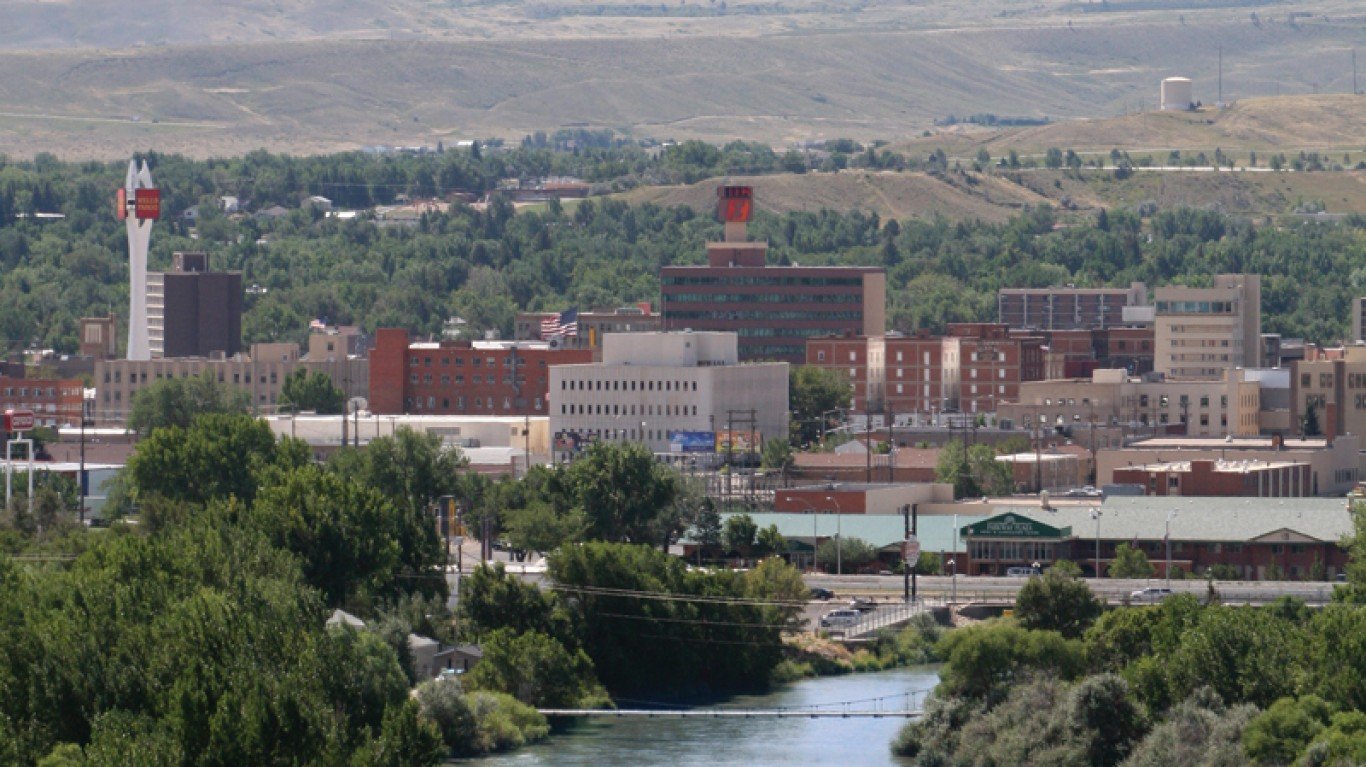
Wyoming: Casper
Avg. new daily cases in Casper in week ending October 7: 93.0 per 100,000
Avg. new daily cases in Casper in week ending September 30: 109.9 per 100,000
COVID-19 cases in Casper as of October 7: 12,877 (16,029.5 per 100,000)
Peak pandemic unemployment in Casper: 12.6% (April 2020)
Casper population: 80,333 (15.0 people per sq. mi.)
Click here to see all coronavirus data for every state.
Take This Retirement Quiz To Get Matched With An Advisor Now (Sponsored)
Are you ready for retirement? Planning for retirement can be overwhelming, that’s why it could be a good idea to speak to a fiduciary financial advisor about your goals today.
Start by taking this retirement quiz right here from SmartAsset that will match you with up to 3 financial advisors that serve your area and beyond in 5 minutes. Smart Asset is now matching over 50,000 people a month.
Click here now to get started.
Thank you for reading! Have some feedback for us?
Contact the 24/7 Wall St. editorial team.
